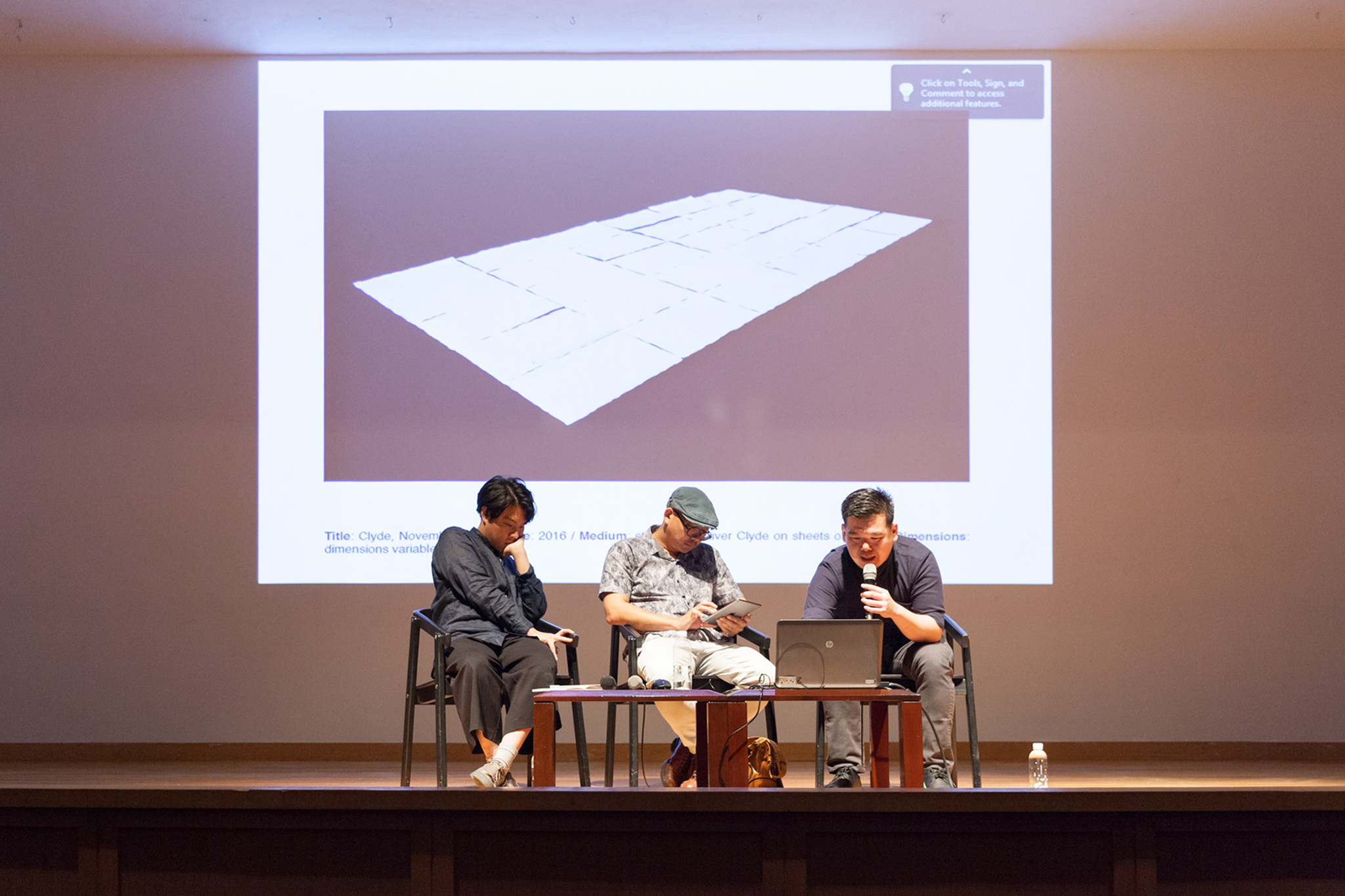THE PUBLIC TALK #1, JOINED BY SORAYUT AIEMUEAYUT AND SUPAPONG LAODHEERASIRI. THE TALK IS ONE OF THE NEXT STEPS ACTIVITIES, A PART OF EARLY YEARS PROJECT 4: PRAXIS MAKES PERFECT EXHIBITION
TEXT: PIMPAKAPORN PORNPENG
PHOTO COURTESY OF BACC
(For English, please scroll down)
Exhibition Talk ครั้งที่ 1 จากโครงการ Early Years Project 4 ที่หอศิลปวัฒนธรรมแห่งกรุงเทพมหานคร เมื่อวันที่ 18 พฤษภาคม ที่ผ่านมา จัดขึ้นภายใต้หัวข้อ “ทวนเวลา ย้อนความเข้าใจ จากมานุษยวิทยาสู่พรมแดนศิลปะ” โดยได้ศรยุทธ เอี่ยมเอื้อยุทธ อาจารย์สาขาสื่อศิลปะและออกแบบสื่อ คณะวิจิตรศิลป์ มหาวิทยาลัยเชียงใหม่ และศุภพงศ์ เหล่าธีรศิริ ศิลปินอิสระ ร่วมวงสนทนา
ศรยุทธเปิดวงสนทนาโดยหยิบยกข้อเขียนเรื่อง ศิลปินในฐานะนักชาติพันธุ์นิพนธ์ (Artist as Ethnographer) ของ Hal Foster มาเชื่อมโยงเข้ากับการทำงานของศิลปิน ที่เก็บข้อมูลในการทำงานศิลปะผ่านวิธีการลงภาคสนามกับชุมชน เขาเสนอว่าการทำงานของศิลปินมีลักษณะที่ใกล้เคียงกับวิธีวิทยาของนักมานุษยวิทยา คือเป็นการศึกษาและนำเสนอจากมุมมองของคนนอก นอกจากนี้ยังตั้งคำถามที่น่าสนใจและชวนขบคิดอย่าง ใครในชุมชนที่เราเลือกสื่อสารด้วย? ข้อมูลที่ได้จากชุมชนนั้นผ่านการคัดกรองจากตัวเราด้วยหรือไม่? และชุมชนมีส่วนร่วมในงานของเรามากน้อยเท่าไร?
ขยับมาที่ช่วงของศุภพงศ์ เหล่าธีรศิริ ศิลปินพูดถึงหัวข้อในการทำงานศิลปะของเขาว่ามาจากประสบการณ์ของตนเอง โดยเริ่มจากสิ่งที่อยู่ใกล้ตัวอย่างเช่น เรื่องของเวลาและความแตกต่างทางวัฒนธรรม ขณะที่ไปศึกษาต่อที่ประเทศสกอตแลนด์ ซึ่งทำให้ผู้ฟังในห้องประชุมและผู้ชมทางบ้านที่ดูวิดีโอย้อนหลัง น่าจะรู้สึกเหมือนกันว่าหัวข้อของการทั้งสนทนาทั้งสองขาดความเชื่อมโยงกัน เพราะดูเหมือนว่าหัวข้อสนทนาของศุภพงศ์นั้นค่อนข้าง “ส่วนตัว” และไม่ได้ออกไปแตะกับชุมชน (ในทางตรง) เท่าไรนัก น่าเสียดายที่บนเวทีเราไม่ได้เห็นมุมมองที่แตกต่างจากฝั่ง “ตัวบท” และ “ศิลปิน” รวมถึงไม่เห็นข้อเสนอแนะจากวิธีการเข้าถึงข้อมูลในฐานะของคนนอกและคนใน ซึ่งคิดว่าน่าจะเป็นแกนหลักของหัวข้อการเสวนาในครั้งนี้อย่างชัดเจนเท่าไรนัก
กิจกรรมนี้เป็นส่วนหนึ่งของกิจกรรมการศึกษา NEXT STEPS ที่จัดขึ้นเพื่อเป็นกิจกรรมเสริม นิทรรศการ Early Years Project 4 : Praxis Makes Perfect สามารถดูวิดีโอบันทึกการเสวนาครั้งนี้ได้ทาง http://bit.ly/2W7u3LW
 The first exhibition talk of Early Years Project 4 recently took place at Bangkok Art and Culture Centre on 18th May 2019. Joining the discussion in the topic ’Reexamining time, retracing understanding, from anthropology to artistic frontier’ are Sorayut Aiemueayut, professor from the Department of Media Arts and Design, Faculty of Fine Arts, Chiang Mai University and independent artist Supapong Laodheerasiri.
The first exhibition talk of Early Years Project 4 recently took place at Bangkok Art and Culture Centre on 18th May 2019. Joining the discussion in the topic ’Reexamining time, retracing understanding, from anthropology to artistic frontier’ are Sorayut Aiemueayut, professor from the Department of Media Arts and Design, Faculty of Fine Arts, Chiang Mai University and independent artist Supapong Laodheerasiri.

Aiemueayut begins the conversation with Foster’s essay, Artist as Ethnographer, referencing artists’ artistic processes which encompass research and data collection where they work closely with local communities through fieldwork. He proposes that artists work relatively close to anthropologists’ methodology, which is essentially the study and presentation from an outsider point of view. He also raises some interesting questions about with whom in the community do artists and anthropologists communicate and whether the obtained data has been selected or filtered somewhat by the people who collect them, including the actual extent of the community’s participation in the produced works.
When Laodheerasiri took the stage, he discussed the subject matters of his art as something that derive from his personal experiences such as the time and cultural differences he’d been through during the time of his postgraduate study in Scotland. At the end of the day, we assume that the viewers who attended the talk and watched the recorded video later would feel the disconnection between the topics and stories of the two speakers simply because Laodheerasiri talked about rather personal experience that doesn’t have that much to do with his personal and direct interaction with the local community. It’s a shame that we didn’t get to see different point of views from both the text’s and ‘artist’s side as much as we’d hoped to nor did we were presented with a tangible suggestion about the possible ways one can have access to the information either as an outsider or insider, which we thought would be the very essence of the discussion after all.
The activity is a part of NEXT STEPS held as a part of Early Years Project 4: Praxis Makes Perfect. To view the recorded talk, visit http://bit.ly/2W7u3LW

